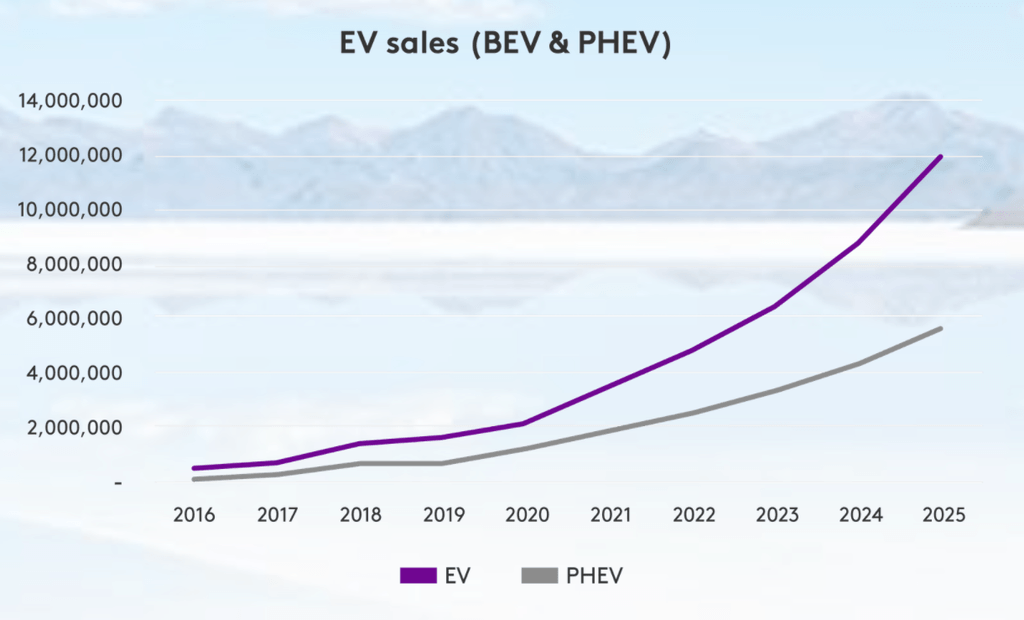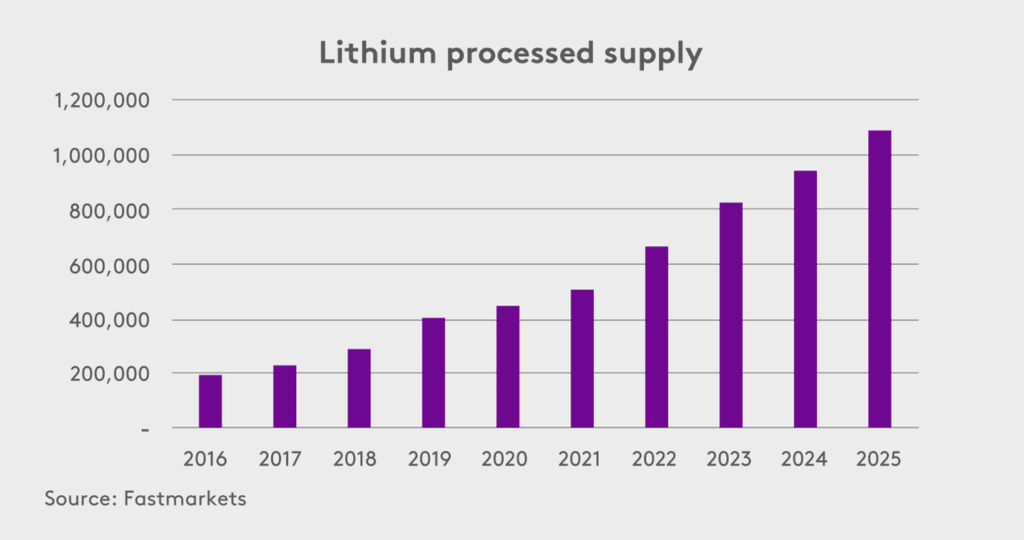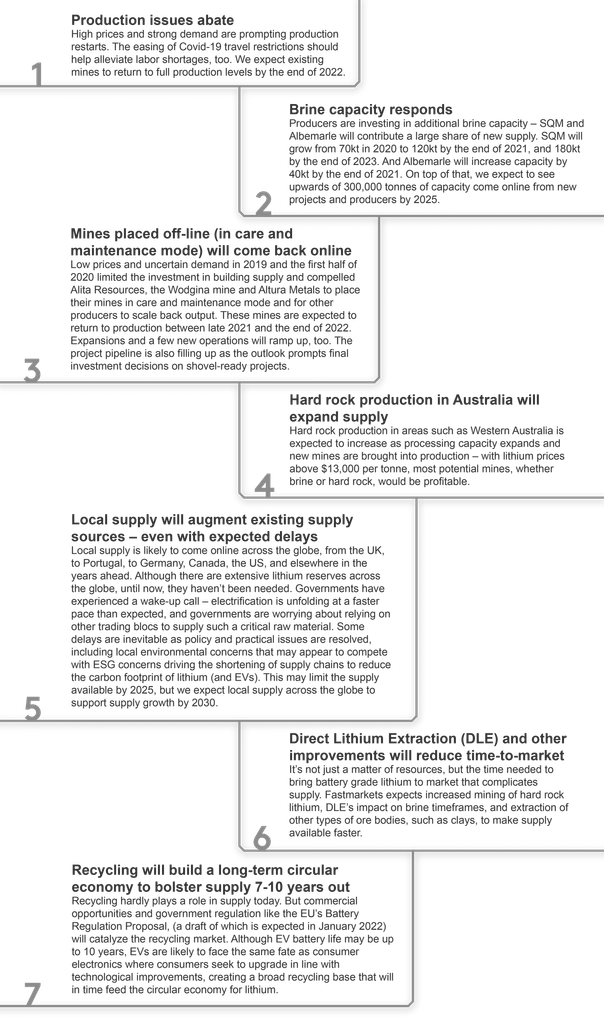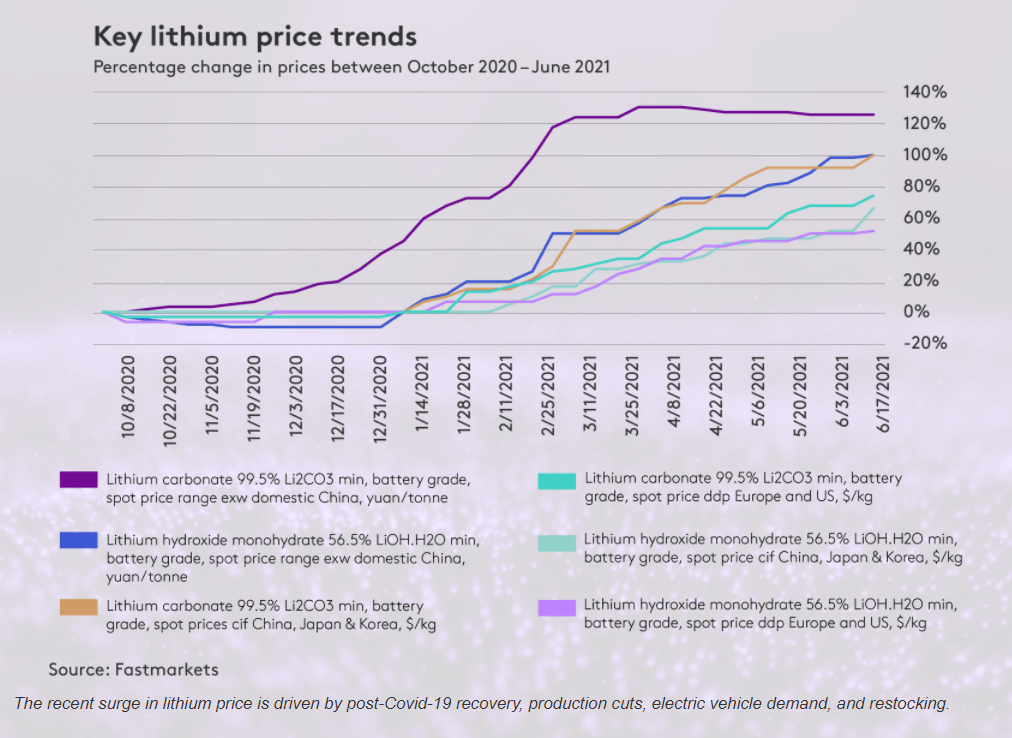The only way is up for lithium demand. Electric vehicle (EV) demand will continue to drive the lithium market forward: EV penetration will reach 15% in 2025, and we expect to see it rise to around 35% by 2030. Add to that mix growing demand from applications such as energy storage systems (ESS), 5G devices, and Internet of Things (IoT) infrastructure.
According to the International Energy Agency, mineral demand for use in EVs and battery storage will grow at least 30 times to 2040 to meet climate goals.
Can supply keep up? Recent market scenarios have painted a picture of dire shortages starting in 2025.
 We don’t believe this is a story of looming, acute shortages – yet. Yes, rapidly growing demand will test the market’s ability to expand supply and reduce lead times. But we believe the market will ultimately respond.
We don’t believe this is a story of looming, acute shortages – yet. Yes, rapidly growing demand will test the market’s ability to expand supply and reduce lead times. But we believe the market will ultimately respond.
So much hinges on the next two to three years, in which the market will be flush with opinions and forecasts, and market participants will be challenged to separate signal from noise. In this report, we look at what’s driving demand, where much-needed additional supply might come from, and what market signals to keep an eye on.
EVs fuel lithium demand
The EV market is the primary driver of lithium demand. We expect EV sales to experience a compound annual growth rate of 40% per year through 2025, when EV penetration is expected to reach 15%.
 Automakers are pursuing different battery strategies, seeking to differentiate drivetrain performance, while aiming for the $100/KWh threshold. Tesla has announced no-cobalt batteries. VW announced its move towards lithium iron phosphate (LFP) batteries and high-manganese batteries. Hyundai has launched a hydrogen-powered EV.
Automakers are pursuing different battery strategies, seeking to differentiate drivetrain performance, while aiming for the $100/KWh threshold. Tesla has announced no-cobalt batteries. VW announced its move towards lithium iron phosphate (LFP) batteries and high-manganese batteries. Hyundai has launched a hydrogen-powered EV.
Regardless of fleet-level or model-level decisions, most batteries will contain 700-800 grams of (lithium carbonate equivalent (LCE) per KWh in the short- to mid-term, and then pull on lithium metal as the market shifts to solid-state batteries in the longer term. Lithium will long continue to be a critical resource to automakers.
That’s why all eyes are on supply.
The many sources of lithium supply
A total of 345,000 tonnes of processed lithium were produced in 2020, dominated by resources from the lithium triangle and Australia.
Production has been disrupted in the past 12-18 months. Covid-19 restrictions in Argentina, and production cut-backs due to low prices in 2019 and 2020 are putting pressure on current production and have slowed the development of projects that would deliver future supply.
 Despite the circumstances of 2020, production is expected to grow steadily to more than 1.03 million tonnes in 2025 and 2 million tonnes in 2030.
Despite the circumstances of 2020, production is expected to grow steadily to more than 1.03 million tonnes in 2025 and 2 million tonnes in 2030.
 Ultimately, supply concerns are not a matter of sufficient reserves, but a question of whether the combined effect of investments, improved methods, and commercial and government conviction can ramp up lithium supplies from across the globe to 2 million tonnes by 2030. We think it is feasible, but so much of that equation hinges on planners and investors being able to differentiate signal from noise over the next two to three years.
Ultimately, supply concerns are not a matter of sufficient reserves, but a question of whether the combined effect of investments, improved methods, and commercial and government conviction can ramp up lithium supplies from across the globe to 2 million tonnes by 2030. We think it is feasible, but so much of that equation hinges on planners and investors being able to differentiate signal from noise over the next two to three years.
Reading market and price signals
The underlying market fundamentals for lithium are straightforward: Increasing and sustained demand will strain supply through 2030. This is a story of two parts: Between now and 2025, supplies from current and planned projects are expected to come online to meet demand; and from 2025 to 2030 new supply sources must come online to support demand.
 The next two to three years will determine how much new supply will come into the market immediately post-2025. The challenge is that as planners, policymakers and end-users determine their best action, they do so in a market that is opaque and noisy, complicating decision-making. The critical need will be to access and interpret signals from across the market that can give clarity.
The next two to three years will determine how much new supply will come into the market immediately post-2025. The challenge is that as planners, policymakers and end-users determine their best action, they do so in a market that is opaque and noisy, complicating decision-making. The critical need will be to access and interpret signals from across the market that can give clarity.
Price signals: Spot markets reflect underlying market dynamics
The Chinese domestic market is often the first to respond to changing supply and demand, closely followed by cif prices for China, Japan and South Korea. But with so many prices nested in long-term contracts, there’s a growing disconnect between contracted and spot market prices. Producers tied into long-term contracts risk missing out on the benefits of exposure to rising lithium prices due to EV demand. Shareholders certainly want some exposure to changes in the lithium market, especially given the outlook, and locking in contracts for such long periods dampens potential returns.
Market signals: Separating signal from noise
Any market has context: historical context, local context, and market context. The challenge for market participants is two-fold: to access information from all corners of the globe and, maybe more importantly, to gain context to understand what any one event may mean and if or how to react. It will be critical to go beyond project insights and gain real context as to expected timing and production levels.
Policy signals: The path to a low-carbon future
International, national and local governments have a significant role to play in setting policy that affects how the lithium market evolves, with tight supply of such a strategically important asset increasing the tendency towards resource nationalism. From the impact of Chile’s new constitution to the environmental, social and cultural challenges facing most new projects. It’s critical that players understand policies and their impact to determine if and how to respond.
Hedging signals: The CME and LME lithium contracts
The London Metal Exchange and CME Group’s recently announced futures contracts enable participants to manage the price risk of volatility, reducing the barriers to entry in a fast-growing market.
The road ahead
Fastmarkets expects continuous pressure on supply through 2030 and beyond as demand increases across the globe. Concerns around strategic shortfalls in lithium are understandable, but we believe that sufficient investment is coming into the market, supported by a steady wave of investment in the longer term and pragmatic policy geared toward a low-carbon future, to ultimately unlock vast lithium resources globally.
The next two to three years are critical for the success of the lithium market to support increasing and sustained demand. Current and future market participants need robust and clear signals to make decisions that guide their strategies and the overall evolution of the lithium market.






